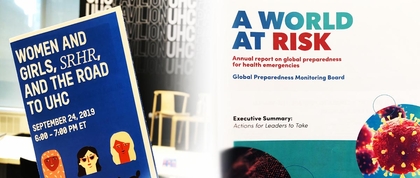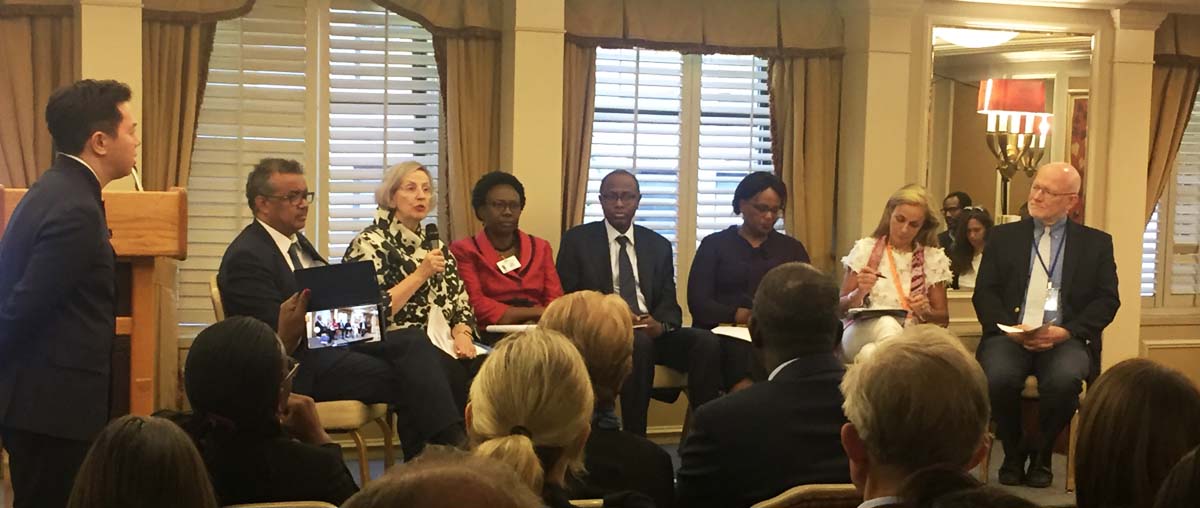
A perspective piece by Undergraduate Student Cassi Niedziela
Pictured: Pamphlets from two UNGA side events
I had the privilege of attending two United Nations General Assembly side events recently: one about preparedness for health emergencies and the other about sexual and reproductive health. It might seem like these events were relatively unrelated, but the similarities in action plans and messages were numerous, proving that various aspects of public health are deeply intertwined.
The basis for the first event was the Global Preparedness Monitoring Board’s first annual report on global readiness for health emergencies, which primarily focuses on epidemics and pandemics. The report highlights seven key actions that actors at all levels must take in order to increase global preparedness for health crises. Overall, the report indicates that we as a planet need to proactively prepare for the next global health emergency because it is not a question of “if,” but “when” the next major crisis arises.

Pictured: Panelists at "A World at Risk: Accelerating Global Preparedness for Health Emergencies"
The second event was about sexual and reproductive health rights and how they need to be incorporated into universal health coverage. Essentially, the speakers noted that UHC cannot be achieved unless sexual and reproductive health services are included, which requires putting women and youth at the forefront of the agenda. This underscores the importance of addressing gender equality within health systems.
While it may seem like preparing for the next pandemic and ensuring sexual and reproductive health coverage for everyone are two very different topics, they must be approached in strikingly similar ways. First, investing in either emergency preparedness or preventative healthcare services reduces costs overall, meaning that inaction will be very costly for governments and individuals alike.
These issues also need to be solved with community-based approaches that focus on the specific needs of the people in a certain area, while simultaneously prioritizing those most at risk. This means investing in people who are historically marginalized and/or will bear the burden of disease the most, while also investing in primary care systems to strengthen the communities as a whole.

Pictured: Panelists at "Women and Girls, SRHR, and the Road to UHC"
Additionally, strengthening communication and trust between government officials, community leaders, health workers, and the general population is key for ensuring that any measures taken by those in power will be effective in targeting the issues at hand.
Hand-in-hand with communication is education. For both of these issues, education results in community empowerment and engagement. For the case of emergency preparedness, educational campaigns about the importance of vaccines or the community protocol when there is an infectious agent have the potential to save countless lives. For the case of sexual and reproductive health, comprehensive rights-based sexual education programs are beneficial for preventing unsafe behaviors, informing people how to seek help when needed, and can even help address power dynamics in relationships that are so often intertwined with gender.
Finally, the promotion of unity and solidarity across a country’s governmental institutions is necessary for responding to either of these public health concerns. It is crucial to link issues together when creating policy because issues are intrinsically intertwined in reality. Climate change influences extreme weather and natural disasters, which can also influence migration patterns and the spread of respiratory pathogens. Gender equality influences domestic violence, which influences the mental health of the parties involved.
No single public health issue stands alone. Each issue is interconnected with countless others, which is why it is so crucial for governments to act and invest in the health of communities across the globe.